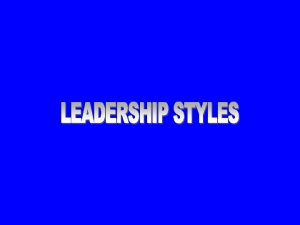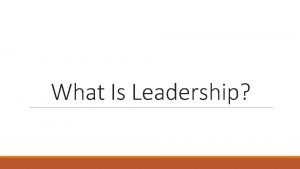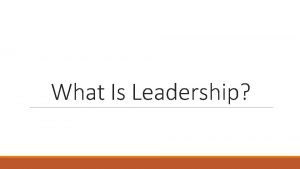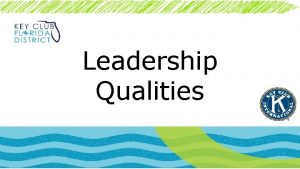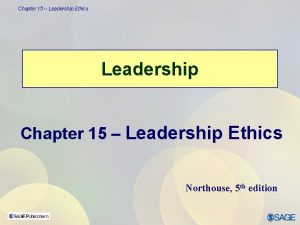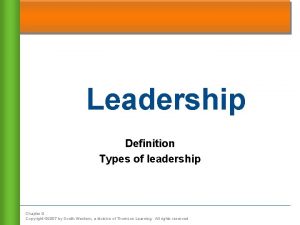Chapter 4 Leadership What is Leadership Definition The














- Slides: 14

Chapter 4: Leadership

What is Leadership? � Definition: The act of influencing, or guiding the activities of a collaborative group towards the achievement of a common goal. � Are individuals born to be leaders, or can anyone acquire the skills necessary to become a leader?

Essential Skills of a Leader

Power � The Five Bases of Social Power � Four Ways to Become more "Important“ ◦ Legitimate Power - The ability to administer to another certain feelings of obligation or the notion of responsibility. ◦ Reward Power - The ability to grant someone things which that person desires or to remove or decrease things the person does not desire. ◦ Expert Power - The ability to administer to another information, knowledge or expertise ◦ Coercive Power - The ability to force someone to do something that he/she does not desire to do ◦ Referent Power - The ability to administer to another a sense of personal acceptance or personal approval. ◦ ◦ Solutions to Uncertainty Resources Make other organizations dependent on you Non-Substitutable

Henri Foyal’s 14 Principals of Management � � � � Division of Work – When employees are specialized, output can increase because they become increasingly skilled and efficient. Authority – Managers must have the authority to give orders, but they must also keep in mind that with authority comes responsibility. Discipline – Discipline must be upheld in organizations, but methods for doing so can vary. Unity of Command – Employees should have only one direct supervisor. Unity of Direction – Teams with the same objective should be working under the direction of one manager, using one plan. This will ensure that action is properly coordinated. Subordination of Individual Interests to the General Interest – The interests of one employee should not be allowed to become more important than those of the group. This includes managers. Remuneration – Employee satisfaction depends on fair remuneration for everyone. This includes financial and non-financial compensation.

Henri Foyal’s 14 Principals of Management Continued � � � � Centralization – This principle refers to how close employees are to the decision-making process. It is important to aim for an appropriate balance. Scalar Chain – Employees should be aware of where they stand in the organization's hierarchy, or chain of command. Order – The workplace facilities must be clean, tidy and safe for employees. Everything should have its place. Equity – Managers should be fair to staff at all times, both maintaining discipline as necessary and acting with kindness where appropriate. Stability of Tenure of Personnel – Managers should strive to minimize employee turnover. Personnel planning should be a priority. Initiative – Employees should be given the necessary level of freedom to create and carry out plans. Esprit de Corps – Organizations should strive to promote team spirit and unity.

Leadership Types � Transactional Leadership ◦ ◦ � � Know what motivates your employees Provide rewards & Punishment Show what is needed to achieve requirements for rewards Provide rewards in a timely manner Charismatic Leadership Big personality, limelight, charm, grace, and self-belief are key Transformational Leadership People follow those who inspire them Vision, Enthusiasm, and Energy are key personality traits Obtain the trust and respect through: ◦ Being Intellectually Stimulating ◦ Tailoring Individualized Motivation ◦ Providing Idealized Motivation

Dimensions of Leadership

Leadership and Communication Styles � In order to become more of a Charismatic/Transformational leader, I think it would be generally agreed that ones communication skill needs to be well developed. In this article, the authors discuss an analysis completed within the Dutch Ministry of Education which utilized a computerized survey to assessed employees views of their leaderships communication style. The six dimensions were: ◦ ◦ ◦ � Verbal aggressiveness Expressiveness Preciseness Assuredness Supportiveness Argumentativeness Utilizing the six dimensions, the study tried to identify which communication styles were most associated with the three types of leadership styles: Transactional, Charismatic, and Transformational.

Leadership and Communication Styles To highlight the analysis results, the researchers found that transformational leaders leaned more towards the supportiveness communication style and showed minimal verbal aggressiveness. � The charismatic leaders had a profile which included every type of leadership style with the exception of expressiveness. � Lastly, the transactional leaders ranked high in assuredness with a much higher correlation of verbal aggressiveness than the other two leadership styles. � With these results, it can be concluded that by enhancing the supportiveness communication style, a leader will be seen as more charismatic and/or transformational. In addition, having high assuredness will improve the perception of a leaders performance and an employees satisfaction with their leader. �

Theory and Practice � � � � Throughout our more recent history, competitive organizations have depended on employee engagement and initiative to support their mission and vision. In order to maintain these characteristics in employees, the managerial structure of the organization must have a proactive climate which encourages and inspires. Thus leading to converting from managing individuals, or ones with formal authority, to inspiring leaders which are able to influence others. Different theories have attempted to develop sets of characteristics that make effective leaders; the first being trait theories. Although trait theories identified ones ability to effectively manage a process, it's vital flaw was the absence of interpersonal relationships and communications, thus leading to the behavior theories. The behavior theories identified the importance addressing employee's feelings and the correlation with willingness to follow. Yet, even though the behavior theories addressed interpersonal relationships, gaps were identified after finding that appropriate leadership types were hindered by situational constraints. Finally leading us to the more recent models which develops and alters their variables and approach depending upon each situation. With most theories being somewhat similar, the key objectives are to apply appropriate behavior to each situation and to create a group of committed followers.

Applying Henri Fayol’s Management Principals � � Henri Fayol contributions to management theory has laid the groundwork for many of our more recent management theories by focusing on six major functions of an organization; those organizational functions are divided into: In an effort to improve upon a managers technical skills, Fayol developed his 14 Principles of Management (as shown above) which he cautioned were flexible and capable of adaptation to every need. To further develop an organizations effectiveness Fayol developed his five basic tools for successful administration which were: ◦ A survey to assess the organizations past and present objectives which include what organizational leaders want to achieve and what the most probably outcomes actually are ◦ A business plan which includes activities needed to be preformed in order to achieve longterm goals ◦ A regularly generated operations report to track initiatives and evaluate performance results ◦ Meeting minutes to provide organizational leaders insight and allow for cross-functional communication ◦ An organizational chart to accurately depict authority and responsibility throughout the scalar chain � When compared to other management theories, Foyal has shown many congruenceis with other theorists most notably that the role of a manager is to motivate, encourage, train, and reward them when success is achieved.

Developing Leadership Skills Exercise Construct your own Board of Directors Following a discussion about how leaders need good role models/mentors, discuss who you would chose to surround yourself with on your personal (or company’s) Board of Directors. Ask everyone to create their own Board of Directors of mentors/role models. These may be people living or dead (or even non-humans – ie. , dogs - or fictional characters – ie. superheroes). They may be people you know or just look up to, people in history, etc. Have the participants share who’s on their Board and why. Talk about how people on your Board can change, depending on where you are at in your life and your leadership journey, and how some people may always be there. You can also talk about who’s Board you might be on as mentor or role model.

References � Barry Armandi, Jeannette Oppedisano, Herbert Sherman, (2003) "Leadership theory and practice: a “case” in point", Management Decision, Vol. 41 Iss: 10, pp. 1076 - 1088 - See more at: http: //www. emeraldinsight. com. prox. lib. ncsu. edu/journals. htm? articleid =865468&show=abstract#sthash. g 2 svsr. Kk. dpuf Mildred Golden Pryor, Sonia Taneja, (2010) "Henri Fayol, practitioner and theoretician – revered and reviled", Journal of Management History, Vol. 16 Iss: 4, pp. 489 - 503 - See more at: http: //www. emeraldinsight. com. prox. lib. ncsu. edu/journals. htm? articleid =1886862&show=abstract#sthash. pk. Q 5 B 6 gi. dpuf Vries, Reinout E. , Bakker-Pieper, Angelique, Oostenveld, Wyneke, (2010) "Leadership = Communication? The Relations of Leaders’ Communication Styles with Leadership Styles, Knowledge Sharing and Leadership Outcomes", Journal of Business and Psychology, Vol. 25 Iss: 3, pp. 367 - 380 - See more at: http: //dx. doi. org/10. 1007/s 10869 -009 -9140 -2 http: //www. mindtools. com/pages/article/henri-fayol. htm
 Hình ảnh bộ gõ cơ thể búng tay
Hình ảnh bộ gõ cơ thể búng tay Frameset trong html5
Frameset trong html5 Bổ thể
Bổ thể Tỉ lệ cơ thể trẻ em
Tỉ lệ cơ thể trẻ em Gấu đi như thế nào
Gấu đi như thế nào Tư thế worms-breton
Tư thế worms-breton Chúa yêu trần thế
Chúa yêu trần thế Các môn thể thao bắt đầu bằng tiếng chạy
Các môn thể thao bắt đầu bằng tiếng chạy Thế nào là hệ số cao nhất
Thế nào là hệ số cao nhất Các châu lục và đại dương trên thế giới
Các châu lục và đại dương trên thế giới Công thức tính độ biến thiên đông lượng
Công thức tính độ biến thiên đông lượng Trời xanh đây là của chúng ta thể thơ
Trời xanh đây là của chúng ta thể thơ Mật thư anh em như thể tay chân
Mật thư anh em như thể tay chân Phép trừ bù
Phép trừ bù độ dài liên kết
độ dài liên kết















